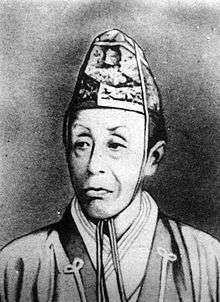Itakura clan
| Itakura clan 板倉氏 | |
|---|---|
| Home province | Mikawa |
| Parent house | Shibukawa clan (Ashikaga clan) |
| Titles | Various |
| Dissolution | still existant |

The Itakura clan (板倉氏 Itakura-shi) is a Japanese clan which came to prominence during the Sengoku period.[1] The family claimed descent from Shibukawa Yoshiaki, the son of Ashikaga Yasuuji, a relative of the Ashikaga shoguns. Over time, the clan evolved into several branches which were daimyo, ruling the Bitchū-Matsuyama, Niwase, Fukushima, and Annaka Domains.
One of Yoshiaki's descendants went to Mikawa Province and entered the service of the Matsudaira clan; the Itakura subsequently became fudai. The Itakura served the Matsudaira clan during its rise to power in the 16th century, and became senior officials in the new Tokugawa shogunate.
In the Edo period, the Itakura were identified as one of the fudai or insider daimyō clans which were hereditary vassals or allies of the Tokugawa clan,[2] in contrast with the tozama or outsider clans.
Itakura clan genealogy
The fudai Itakura clan originated in 17th century Mikawa province.[2] They claim descent from the Seiwa-Genji through the Shibukawa branch of the Imperial family.[3]
- The senior or main branch of the Itakura was created 1609.[2] After the Battle of Sekigahara, the Itakura were given significant responsibilities in the evolving shogunal government. Itakura Katsushige (1542–1624) was made the Kyoto shoshidai in 1601; and he continued to hold this high office during the next twenty years. During this period, Katsushige saw significant increases in the revenues allotted to him by the shogunate. His importance within the shogunate can be measured by the record of grown in his annual expected income which rose to 40,000 koku; however, he had no castle in his charge. As compensation of sort, Katsushige was given the title Iga no kami.[4] Itakura Shigemune (1587–1656) was the oldest son of Katsushige; and he succeeded to the office of Kyoto shoshidai in 1620. He would continue to hold this office through 1654. Two years later, he became daimyō at Sekiyado Domain (50,000 koku) in Shimōsa province. Itakura Shigesato (1620–1660), the oldest son of Shigemune, was known as Awa no kami and he held the shogunate title of Jisha-bugyō. His descendants would reside successively at Kameyama Domain in Ise Province in 1669; at Toba Domain in Shima province in 1710; at Kameyama in Ise Province in 1717; and finally, from 1744 through 1868, at Matsuyama (50,000 koku) in Bitchū Province. The head of this clan line was ennobled as a "Viscount" in the Meiji period.[3]
- A cadet branch of the Itakura was created in 1624[2] for the progeny of Itakura Shigemasa (1588–1638), the second son of Itakura Katsushige. He was honored with 15,000 koku from the revenues of Mikawa province in acknowledgment of his conduct during the Siege of Osaka in 1615. Subsequently, Itakura Shigenori (1617–1673), the son of Shigemasa, was the Osaka jodai and rōjū, and then Kyoto shoshidai in 1668. In 1672, he received the fief of Kasuyama (60,000 koku) in Shimotsuke province. Itakura Shigetane (1640–1705), the son of Shigenori, was installed in 1680 at Iwatsuki Domain in Musashi province, and in the following year, he was transferred to Sakamoto Domain in Shinano province. Later, Itakura Shigehiro was established at Fukushima Domain (80,000 koku) in Mutsu province where his descendants remained up through the Meiji Restoration in 1868. The head of this clan line was ennobled as a "Viscount" in the Meiji period.[3]
- Another cadet branch was created in 1661.[2] The members of this clan resided successively in 1681 at Annaka Domain (15,000 koku) in Kōzuke province; in 1702 at Izumi Domain (20,000 koku) in Mutsu province; in 1746 at Sagara Domain (25,000 koku) in Tōtōmi province; and eventually, from 1749 through 1868 at Annaka Domain (30,000 koku) in Kōzuke province. The head of this clan line was ennobled as a "Viscount" in the Meiji period.[3]
- A further cadet branch created 1683.[2] This branch of the Itakura lived continuously from 1699 through 1868 at Niwase Domain (20,000 koku) in Bitchū province. The head of this clan line was ennobled as a "Viscount" in the Meiji period.[3]
Notable clan members
Itakura Katsukiyo, the famous shogunate official, was a prominent member of this clan from the 19th century. Another was Itakura Shigemasa, the first leader of the shogunate's armies at the Shimabara Rebellion; Shigemasa was killed in action there.
- This is a dynamic list and may never be able to satisfy particular standards for completeness. You can help by expanding it with reliably sourced entries.
- Itakura Katsushige, 1542–1624–2nd Kyoto shoshidai.[1]
- Itakura Shigemune, 1587–1656–3rd Kyoto shoshidai.[1]
- Itakura Shigesato, 1620–1660
- Itakura Shigemasa, 1588–1638
- Itakura Shigenori, 1617–1673–5th Kyoto shoshidai.[1]
- Itakura Shigetane, 1640–1705
- Itakura Shigehiro
- Itakura Katsukiyo, 1823-1889
- Itakura Katsunori - House of Peers (1925).[5]
Notes
- 1 2 3 4 Meyer, Eva-Maria. "Gouverneure von Kyôto in der Edo-Zeit." Universität Tübingen (in German).
- 1 2 3 4 5 6 Appert, Georges. (1888). Ancien Japon, p. 68.
- 1 2 3 4 5 Papinot, Jacques. (2003). Nobiliare du Japon -- Itakura, pp. 16-17; Papinot, Jacques Edmond Joseph. (1906). Dictionnaire d’histoire et de géographie du Japon. (in French/German).
- ↑ Papinot, p. 16.
- ↑ "Nobility, Peerage and Ranks in Ancient and Meiji-Japan," p. 14.
References
- Appert, Georges and H. Kinoshita. (1888). Ancien Japon. Tokyo: Imprimerie Kokubunsha.
- Meyer, Eva-Maria. (1999). Japans Kaiserhof in de Edo-Zeit: Unter besonderer Berücksichtigung der Jahre 1846 bis 1867. Münster: Tagenbuch. ISBN 3-8258-3939-7
- Papinot, Jacques Edmund Joseph. (1906) Dictionnaire d'histoire et de géographie du japon. Tokyo: Librarie Sansaisha...Click link for digitized 1906 Nobiliaire du japon (2003)
- Sasaki, Suguru. (2002). Boshin sensō: haisha no Meiji ishin. Tokyo: Chūōkōron-shinsha.
See also
- Joseph Hardy Neesima
- (Japanese) Itakura clan on Harimaya's "Buke-kaden" (22 Sept. 2007)